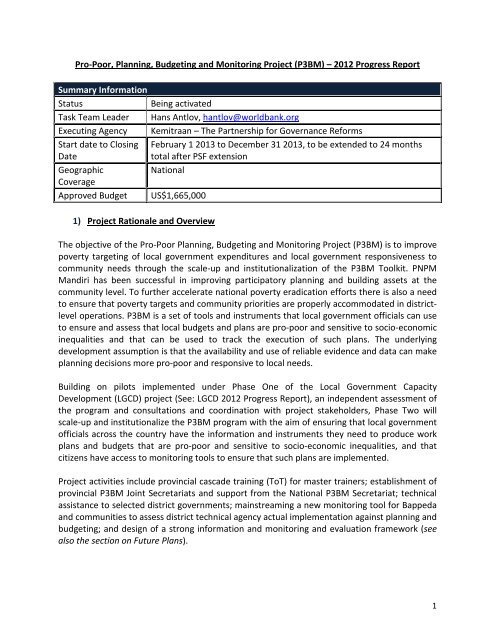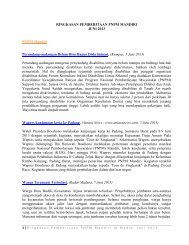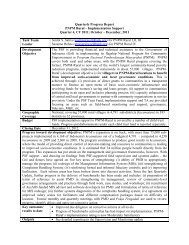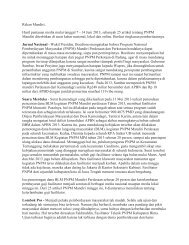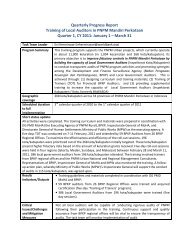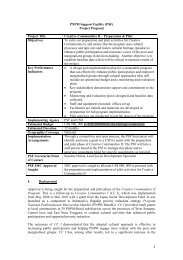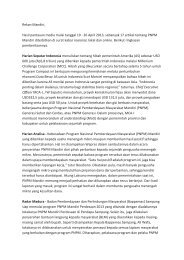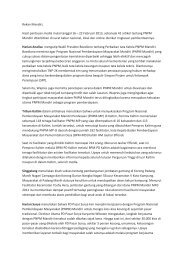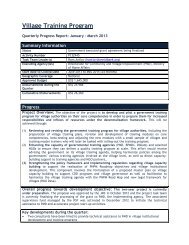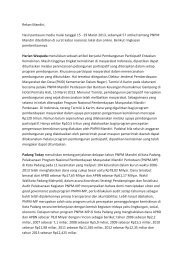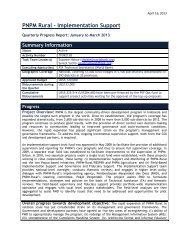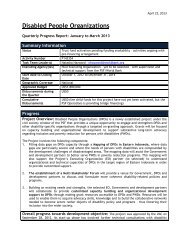Pro-Poor, Planning, Budgeting and Monitoring Project (P3BM ...
Pro-Poor, Planning, Budgeting and Monitoring Project (P3BM ...
Pro-Poor, Planning, Budgeting and Monitoring Project (P3BM ...
Create successful ePaper yourself
Turn your PDF publications into a flip-book with our unique Google optimized e-Paper software.
<strong>Pro</strong>-<strong>Poor</strong>, <strong>Planning</strong>, <strong>Budgeting</strong> <strong>and</strong> <strong>Monitoring</strong> <strong>Pro</strong>ject (<strong>P3BM</strong>) – 2012 <strong>Pro</strong>gress Report<br />
Summary Information<br />
Status<br />
Task Team Leader<br />
Executing Agency<br />
Start date to Closing<br />
Date<br />
Geographic<br />
Coverage<br />
Approved Budget<br />
Being activated<br />
Hans Antlov, hantlov@worldbank.org<br />
Kemitraan – The Partnership for Governance Reforms<br />
February 1 2013 to December 31 2013, to be extended to 24 months<br />
total after PSF extension<br />
National<br />
US$1,665,000<br />
1) <strong>Pro</strong>ject Rationale <strong>and</strong> Overview<br />
The objective of the <strong>Pro</strong>-<strong>Poor</strong> <strong>Planning</strong>, <strong>Budgeting</strong> <strong>and</strong> <strong>Monitoring</strong> <strong>Pro</strong>ject (<strong>P3BM</strong>) is to improve<br />
poverty targeting of local government expenditures <strong>and</strong> local government responsiveness to<br />
community needs through the scale-up <strong>and</strong> institutionalization of the <strong>P3BM</strong> Toolkit. PNPM<br />
M<strong>and</strong>iri has been successful in improving participatory planning <strong>and</strong> building assets at the<br />
community level. To further accelerate national poverty eradication efforts there is also a need<br />
to ensure that poverty targets <strong>and</strong> community priorities are properly accommodated in districtlevel<br />
operations. <strong>P3BM</strong> is a set of tools <strong>and</strong> instruments that local government officials can use<br />
to ensure <strong>and</strong> assess that local budgets <strong>and</strong> plans are pro-poor <strong>and</strong> sensitive to socio-economic<br />
inequalities <strong>and</strong> that can be used to track the execution of such plans. The underlying<br />
development assumption is that the availability <strong>and</strong> use of reliable evidence <strong>and</strong> data can make<br />
planning decisions more pro-poor <strong>and</strong> responsive to local needs.<br />
Building on pilots implemented under Phase One of the Local Government Capacity<br />
Development (LGCD) project (See: LGCD 2012 <strong>Pro</strong>gress Report), an independent assessment of<br />
the program <strong>and</strong> consultations <strong>and</strong> coordination with project stakeholders, Phase Two will<br />
scale-up <strong>and</strong> institutionalize the <strong>P3BM</strong> program with the aim of ensuring that local government<br />
officials across the country have the information <strong>and</strong> instruments they need to produce work<br />
plans <strong>and</strong> budgets that are pro-poor <strong>and</strong> sensitive to socio-economic inequalities, <strong>and</strong> that<br />
citizens have access to monitoring tools to ensure that such plans are implemented.<br />
<strong>Pro</strong>ject activities include provincial cascade training (ToT) for master trainers; establishment of<br />
provincial <strong>P3BM</strong> Joint Secretariats <strong>and</strong> support from the National <strong>P3BM</strong> Secretariat; technical<br />
assistance to selected district governments; mainstreaming a new monitoring tool for Bappeda<br />
<strong>and</strong> communities to assess district technical agency actual implementation against planning <strong>and</strong><br />
budgeting; <strong>and</strong> design of a strong information <strong>and</strong> monitoring <strong>and</strong> evaluation framework (see<br />
also the section on Future Plans).<br />
1
The Phase Two of the <strong>P3BM</strong> project was approved by the JMC in April 2012 <strong>and</strong> will be<br />
operational in January 2013, with Kemitraan/Partnership for Governance Reforms as<br />
implementing agency, with Bappenas’ Poverty Reduction Unit providing strategic guidance.<br />
2) <strong>Pro</strong>gress in Previous Years<br />
The <strong>P3BM</strong> toolkit was originally designed in 2007-2009 by ADB <strong>and</strong> UNDP. Since 2010, the<br />
<strong>P3BM</strong> program has been managed by Bappenas, who requested support from the PSF for<br />
capacity-building <strong>and</strong> an initial series of pilots under the Local Government Capacity<br />
Development (LGCD) project. During this first phase (2010-2012), training in the <strong>P3BM</strong> toolkit<br />
was provided for 32 national master trainers <strong>and</strong> 60 provincial master trainers, who in turn<br />
trained 213 officials from 29 local governments. <strong>P3BM</strong> trainings <strong>and</strong> workshops were<br />
conducted in collaboration with PNPM-Urban <strong>and</strong> PNPM-Integrasi which resulted in a more<br />
integrated approach in the local planning practice. A network of <strong>P3BM</strong> <strong>and</strong> MDG scorecards<br />
practitioners was established, with the potential of raising awareness of the need of local<br />
government to be more responsive to community needs. Following-up on the <strong>P3BM</strong> training,<br />
the provincial <strong>and</strong> district governments in Banten, East Nusa Tenggara, Pekalongan, Bekasi,<br />
Depok, East Belitung, Cilegon, <strong>and</strong> Serang financed a series of <strong>P3BM</strong> trainings to support the<br />
rolling-out of the <strong>P3BM</strong> toolkit <strong>and</strong> improve pro-poor planning <strong>and</strong> budgeting. Outcomes in<br />
these locations included the establishment of a database system on MDGs <strong>and</strong> local<br />
development which feeds into the district planning <strong>and</strong> budgeting document. Poverty data has<br />
been verified <strong>and</strong> validated through multi-stakeholder forum, while in Banten a <strong>P3BM</strong> Clinic has<br />
been established through a Governor’s Decree to institutionalize pro-poor planning <strong>and</strong><br />
support village planning processes.<br />
In 2011, an independent evaluation of <strong>P3BM</strong> was conducted in 10 districts to assess the<br />
effectiveness of the toolkit to support local government to produce better targeting in their<br />
planning <strong>and</strong> budgeting documents <strong>and</strong> also to identify barriers <strong>and</strong> challenges in the adoption<br />
<strong>and</strong> institutionalization of such tools. The evaluation showed that <strong>P3BM</strong> has been beneficial for<br />
target local governments in three main fields: poverty data management, providing directions<br />
for pro-poor planning, <strong>and</strong> improvement of planning documents. Key results reported were:<br />
a. Several target jurisdictions reported that their annual SKPD plans have been revised based<br />
on poverty targets after applying <strong>P3BM</strong>;<br />
b. District mid-term development planning <strong>and</strong> annual budgeting were revised based on MDG<br />
targets, closing the gaps between various planning documents <strong>and</strong> ensure consistency<br />
between planning <strong>and</strong> budgeting;<br />
c. Large positive response from the regions (including provincial governments), with many<br />
jurisdictions requesting advanced training <strong>and</strong> technical assistance;<br />
d. TNP2K were referencing <strong>P3BM</strong> as a key tool for subnational governments in the planning<br />
<strong>and</strong> implementation of GoI poverty reduction programs;<br />
e. UNDP was committed to continue support for the institutionalization <strong>and</strong> alignment of<br />
<strong>P3BM</strong> into national regulation <strong>and</strong> MDG policy, <strong>and</strong> support NGOs to use the monitoring<br />
module to track development targets.<br />
2
With this positive outcome, Bappenas requested that the <strong>P3BM</strong> component under LGCD was<br />
scaled-up under a separate trust fund.<br />
3) <strong>Pro</strong>gress in 2012<br />
The JMC endorsed the design for Phase Two in April 2012. With funding from the LGCD project,<br />
a limited number of activities were carried out in 2012 to prepare for the launch of Phase Two.<br />
A second batch of 25 national master trainers were trained in September 2012, <strong>and</strong> a refresher<br />
course was provided for 32 master trainer originally trained in 2008-2010. To try-out the Phase<br />
Two model, facilitation of <strong>P3BM</strong> training was provided in the provinces of Papua, West Papua,<br />
Gorontalo <strong>and</strong> Bangka-Belitung <strong>and</strong> the districts of Lombok Tengah, Lebak, Pagar Alam, Kubu<br />
Raya, Depok, Cilegon <strong>and</strong> Serang, funded by local budgets (APBD), Bappenas <strong>and</strong> UNDP.<br />
Some of the weaknesses of the <strong>P3BM</strong> approach which were identified during assessments,<br />
including an almost exclusive focus on planning (See also Lessons Learned section below), have<br />
been addressed through this new design. Revisions include:<br />
a. A new monitoring module will be tried out <strong>and</strong> implemented. This module will consist of<br />
two parts: first, a third party monitoring <strong>and</strong> expenditure tracking tool for development<br />
plans (including NGO, local universities <strong>and</strong> communities); <strong>and</strong> second, a part that will<br />
allow tracking by local government authorities of SKPD expenditures. This will allow a<br />
stronger focus on the quality of actual expenditure, not just what is in the plan.<br />
b. The <strong>P3BM</strong> National Secretariat will work closely with Bappenas <strong>and</strong> TNP2K to explore<br />
possibilities to provide incentives for local governments to make plans more sensitive to<br />
MDG targets (<strong>and</strong> to use the <strong>P3BM</strong> toolkit). This will include providing public recognition to<br />
high-performing districts <strong>and</strong> to provide additional financial support to certain areas to<br />
meet the MDG targets, encouraging the use of <strong>P3BM</strong>. This endeavour to make local<br />
government planning <strong>and</strong> budgeting pro-poor <strong>and</strong> sensitive to poverty targets is supported<br />
by the recent Law no 13/2011 on “Management of the <strong>Poor</strong>”, encouraging subnational<br />
governments to undertake pro‐poor programs with their own resources.<br />
c. The target audience of <strong>P3BM</strong> stakeholders will be enlarged to include DPRD members.<br />
Options will be explored for involving the DPRD Secretariat (Sekwan) <strong>and</strong> the DPRD Budget<br />
Commission in training. DPRD members will also actively participate when the analytical<br />
results of <strong>P3BM</strong> are being discussed by the government. This might contribute to greater<br />
consistency between priorities in the planning <strong>and</strong> the budgeting process.<br />
A mapping of various local governments’ pro-poor planning <strong>and</strong> budgeting instruments was<br />
carried out, providing recommendations to Bappenas’ Poverty Reduction Unit. A coordination<br />
meeting was held by Bappenas in April 2012 to discuss the mapping results <strong>and</strong> agree on<br />
follow-up actions with regard to <strong>P3BM</strong> scale-up plans. A number of meetings were also<br />
conducted to initiate closer collaboration with the MDG National Secretariat <strong>and</strong> TNP2K with<br />
regard to the implementation of <strong>P3BM</strong>. Finally, during the 2012 Musrenbang development<br />
planning cycle, the <strong>P3BM</strong> toolkit was piloted in a number of sub-districts in Serang (Banten),<br />
showing very positive results in the type of village proposals were prioritized, with a strong<br />
3
focus on maternal <strong>and</strong> neo-natal health, which had been identified as a critical issue in Serang.<br />
This approach will be incorporated into Phase Two.<br />
The processing of the grant agreement with Kemitraan is progressing well <strong>and</strong> signing is<br />
expected in early 2013.<br />
4
4) Key Results<br />
Result<br />
Indicators<br />
Unit of<br />
Measure<br />
Baseline<br />
Total Target<br />
Before<br />
2011<br />
Targets (cumulative)<br />
2011 2012 2013 2014 2015<br />
Delivered<br />
in 2012<br />
(only)<br />
Cumulative<br />
<strong>Pro</strong>gress as<br />
of Dec 31,<br />
2012<br />
Difference<br />
with<br />
cumulative<br />
target for<br />
2012<br />
Comments<br />
on<br />
progress<br />
PDO: To improve poverty targeting of local government expenditures <strong>and</strong> local government responsiveness to community needs through the scale-up <strong>and</strong><br />
institutionalization of the <strong>P3BM</strong> program.<br />
11 LGs<br />
# of local<br />
adopted<br />
governments<br />
<strong>P3BM</strong> in<br />
that have<br />
2012 under<br />
adopted<br />
LGCD phase<br />
11<br />
poverty # of LGs<br />
71 - - - 31 71 - - - -<br />
one – 60<br />
(2012)<br />
targeting in<br />
‘additional<br />
annual<br />
LGs’<br />
development<br />
planned<br />
planning<br />
under this<br />
project<br />
Increased<br />
percentage<br />
of direct LG<br />
budgets<br />
allocated for<br />
MDG<br />
targeting <strong>and</strong><br />
povertyrelated<br />
spending<br />
% of<br />
budget<br />
Baseline<br />
survey<br />
in early<br />
2013<br />
+7.5% (TBC) 0 0 0 5% 7.5% - - - -<br />
Component 1: <strong>Pro</strong>vincial cascade training for Master Trainers <strong>and</strong> Technical Assistance for <strong>Pro</strong>vinces<br />
# master<br />
trainers<br />
trained<br />
# of<br />
trainees<br />
152<br />
(2012)<br />
432 - - - 272 432 - - - -<br />
Increases<br />
should start<br />
materializin<br />
g in 2013.<br />
152<br />
trainees<br />
under<br />
LGCD, 280<br />
additional<br />
planned<br />
5
under this<br />
project<br />
# of <strong>P3BM</strong><br />
provincial<br />
clinics<br />
established<br />
# of CSOs <strong>and</strong><br />
community<br />
groups that<br />
use <strong>P3BM</strong><br />
instruments<br />
to track<br />
district propoor<br />
expenditures<br />
# of clinic<br />
established<br />
2 (2012) 17 - - - 12 17 - - - -<br />
# of CSOs 0 60 - - - 30 60 - - - -<br />
Component 2: Establish a National Secretariat <strong>and</strong> <strong>Pro</strong>vide Institutional Support<br />
Business plan<br />
developed<br />
for the longterm<br />
sustainability<br />
of <strong>P3BM</strong><br />
District-level<br />
MDG data<br />
improved<br />
# of<br />
business<br />
plans<br />
Use of<br />
database<br />
0<br />
Business plan<br />
implemented<br />
Database<br />
rolled-out<br />
nationally by<br />
TNP2K &<br />
Nat’al MDG<br />
Secretariat<br />
- -<br />
- - -<br />
BP<br />
draft<br />
ed<br />
DB<br />
prep<br />
ared<br />
BP<br />
Impl<br />
eme<br />
nted<br />
DB<br />
rolle<br />
d<br />
out<br />
- -<br />
- - - -<br />
2 clinics<br />
established<br />
under<br />
LGCD, 15<br />
additional<br />
planned<br />
under this<br />
project<br />
Activities to<br />
begin in<br />
2013<br />
Activities to<br />
begin in<br />
2013<br />
Activities to<br />
begin in<br />
2013<br />
6
5) Lessons learned<br />
• <strong>P3BM</strong> needs to focus more on monitoring <strong>and</strong> quality of expenditure. To date, the<br />
program has been heavily focused on planning, <strong>and</strong> is not linked to implementation <strong>and</strong><br />
spending quality of service delivery. This has limited the impact of the toolkit, since<br />
there is a discrepancy between planning, budgeting <strong>and</strong> actual service delivery. There<br />
are also important lessons with regard to the capacity of local government to adopt the<br />
tools, the logistical constraints to actually have the data available to make the tool<br />
effective, the political will in the district <strong>and</strong> in the technical agencies to actually use the<br />
tool, <strong>and</strong> the lack of clarity on the platform (TKPKD) where this tool will be used.<br />
Adjustments have been made for Phase Two to address these weaknesses.<br />
• District-level poverty data <strong>and</strong> information needs to be better coordinated. Based on<br />
pilots during Phase One, this will addressed during Phase Two through “Forum Data” at<br />
the province <strong>and</strong> district level where consolidation of existing data on poverty <strong>and</strong><br />
MDGs status generated from the Central Bureau of Statistics (BPS), Bappeda <strong>and</strong> SKPD<br />
will take place, agreed by local stakeholders, facilitated by the project. The provincial<br />
<strong>P3BM</strong> secretariats will also be encouraged to collaborate with PNPM programs to<br />
ensure that accurate poverty data are also made available at the community level.<br />
TNP2K in collaboration with UNDP are also supporting the improvement of poverty data<br />
at the sub-national level <strong>and</strong> discussions for collaboration in data collection <strong>and</strong> analysis<br />
are taking place.<br />
• In order to achive expected results, Bupati <strong>and</strong> DPRD must be invited during <strong>P3BM</strong><br />
socialisation <strong>and</strong> launching of program activities, getting their support to the analysis<br />
conducted by government officials taking part in the <strong>P3BM</strong> training. Likewise, involving<br />
Camat during sub-district training proved effective in terms of collecting more<br />
comprehensive poverty data <strong>and</strong> to support the harmonisation of data from village to<br />
sub-district level. The involvement of Camat also have been usefull in supporting<br />
integration of participatory planning with regular planning.<br />
6) Future plans<br />
With the Grant Agreement to be signed with implementing agency Kemitraan during early<br />
2013, Phase Two will fully launch during the first quarter of 2013. Key activities which will be<br />
conducted include:<br />
• <strong>Pro</strong>vincial cascade training (ToT) for Master Trainers. The scale-up of <strong>P3BM</strong> will continue<br />
the cascade training began under Phase One. The national master trainers will train an<br />
additional 280 provincial master-trainers clustered into six larger regional events. Training<br />
of trainers will also be done at the national level to increase the number of National Master<br />
Trainers to facilitate province <strong>and</strong> districts’ requests of <strong>P3BM</strong> training <strong>and</strong> technical<br />
7
assistance. Training will be done not only on <strong>P3BM</strong>, but also facilitation skills including<br />
interactive training design.<br />
• Packages of Technical Assistance for <strong>Pro</strong>vinces. These <strong>P3BM</strong> master trainers (national <strong>and</strong><br />
provincial) will respond to the needs of local governments to improve their planning,<br />
budgeting <strong>and</strong> public service monitoring. They will provide continuous technical assistance<br />
to district governments in terms of the utilization of the <strong>P3BM</strong> instruments to improve<br />
their development planning. 15 provinces will be selected for further support, based on a<br />
commitment to share costs for the training <strong>and</strong> technical assistance. In these 15 provinces,<br />
“<strong>P3BM</strong> Joint Secretariats” will be established, consisting of the pool of <strong>Pro</strong>vincial Master<br />
Trainers supported by a small secretariat. Activities managed by the subnational <strong>P3BM</strong><br />
Task Force (with support from the National Secretariat) include: (i) providing technical<br />
assistance (but no funding) for district governments that have adopted the <strong>P3BM</strong><br />
approach, (ii) developing MDG information offices; <strong>and</strong> (iii) mainstreaming a new<br />
monitoring tool for Bappeda <strong>and</strong> communities to assess local government technical<br />
agencies actual implementation against planning <strong>and</strong> budgeting.<br />
• Institutional Support <strong>and</strong> National Secretariat. A system to institutionalize <strong>and</strong> provide<br />
national information about the <strong>P3BM</strong> will be designed that includes core support for the<br />
National Secretariat, establishment of national <strong>P3BM</strong> task force (consisting of the national<br />
master training who will provide support at the province level) <strong>and</strong> design of a strong<br />
information <strong>and</strong> monitoring <strong>and</strong> evaluation framework. This will involve regular tracking of<br />
the results of <strong>P3BM</strong> training, documenting best practices, <strong>and</strong> publicizing regular <strong>P3BM</strong><br />
newsletter <strong>and</strong> updates on national MDG/poverty targets.<br />
7) Disbursement Performance<br />
N/A: Implementation will start in 2013.<br />
8


